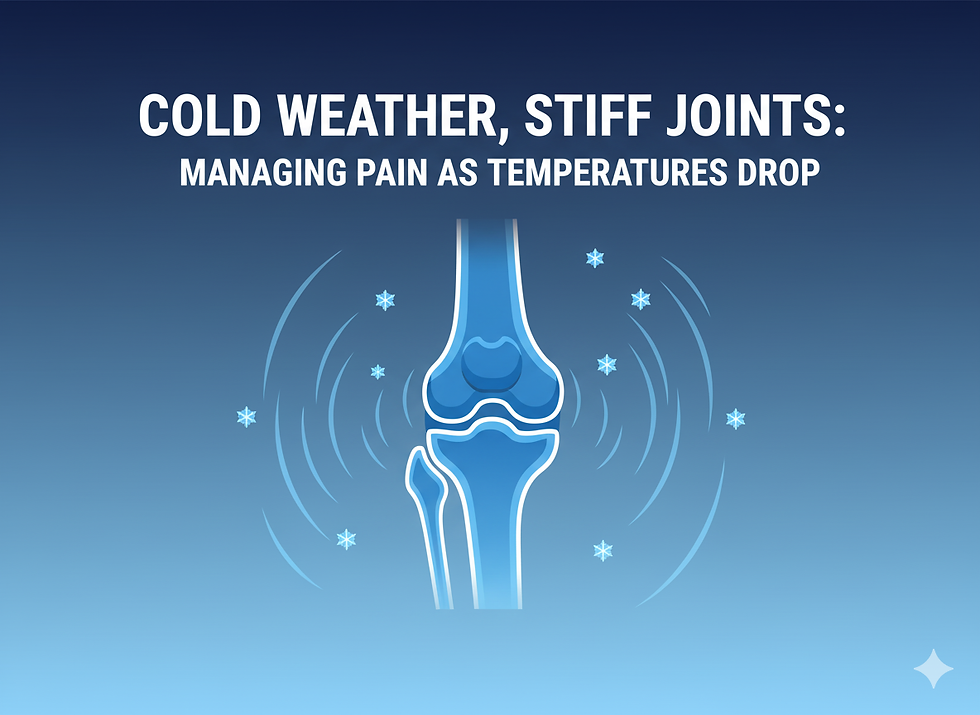Reducing Your Risk of Falling
- K-Town Physio

- Feb 28, 2022
- 3 min read
Updated: Mar 23, 2022

Picture this: it’s a crisp, cold winter’s day in Kingston. You’ve just pulled into your driveway in your toasty warm vehicle, back from picking up groceries, and you are ready to bring everything inside. You open your car door, swing your legs to the side, and step directly onto a patch of black ice. Your legs go flying, your heart starts beating a mile a minute, and you land directly on your backside on your driveway. You sit on the ground, moaning and groaning, looking around to see if any of your neighbours witnessed your ungraceful fall onto your now very sore tailbone. Unfortunately, this is an all-too-common experience for us Canadians as we wade our way through winter snows, freezing rain, shovelling marathons and dreaded evil sleet. We’re not trying to be humerus here - slips and falls are a real risk and this blog post will explore some ways that you can reduce your probability of falling.
While black ice is something that is somewhat out of our control, there are ways that you can reduce your risk of losing balance and falling over. Falls are the leading cause of injury-related hospitalizations in adults over the age of 65 years, and can result in upper extremity, hip and pelvic fractures, dislocations, muscle strains, head injuries, and impacts to mental health regarding fear of falling and the effects of immobility (1). Fortunately, falls can be prevented. Here are some exercises that will help to improve your strength and balance and reduce your risk of falling.
Try 1-2 rounds of these exercises per day, as tolerated.
Supported Squat
Stand in front of a counter/chair/railing and hold onto the support.
While keeping your back straight, slowly lower your body into a semi-squat position without leaning forward and keeping your heels in contact with the ground.
Stand back up straight by using your leg strength.
For extra safety, have a chair or bench behind you to sit on for rest. (Progression would be to loosen your grip on the support as you feel more balanced through the movement)
Try 5-10 repetitions as tolerated.

Supported Standing Heel & Toe Raises
Hold onto the back of a steady chair or counter.
Lift your toes up so that you are standing on your heels.
Then lift your heels up so that you are standing on your toes.
Try 10 repetitions of each movement.

Tandem Balance Walking
Stand up straight beside a table or kitchen counter and hold onto it.
Step forward in a straight line as though you were walking on a tight-rope.
Make sure that the heel of one foot touches the toe of the other every time you step forward. (To progress, repeat without holding onto the table.)
Try 10 steps forward per foot.

Single leg balance (flat ground)
Stand in front of a counter or wall if needed to maintain balance.
Lift one leg off the ground, while standing stable on the other without losing your balance. (Progression option below with the towel or pillow)
Try 10 seconds per leg, repeat 3 times per side.

Single leg balance (unsteady surface)
Stand on a towel or pillow with your feet comfortably apart.
Lift one foot and balance yourself on the other leg.
Get back on two feet and repeat.
Try 10 seconds per leg, repeat 3 times per side.

Other strategies to help reduce your risk of falls should include: (2)
increasing your regular general exercise (ie. walking program, Tai Chi)
making your home safer by decreasing tripping hazards
managing existing pain and injuries
considering appropriate footwear choices for around your house and for different outdoor environments
improving your sleep habits
Physiotherapy is not only important for treating the injuries that occur as the result of a fall. Physiotherapists can help you to develop your strength, improve your balance and reduce your risk of falling in the first place. Contact our team today to learn more!
Written by Joel Winsor, Registered Physiotherapist
Exercise photos from Physiotec
References:
Seniors’ Falls in Canada second report. (n.d.). https://www.phac-aspc.gc.ca/seniors-aines/publications/public/injury-blessure/seniors_falls-chutes_aines/assets/pdf/seniors_falls-chutes_aines-eng.pdf
Falls. (2012). Physiopedia. https://www.physio-pedia.com/Falls



